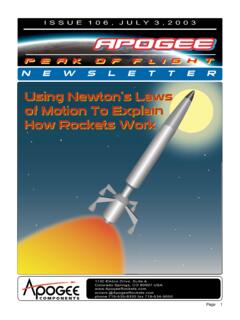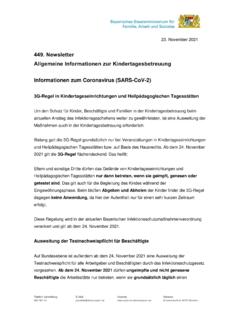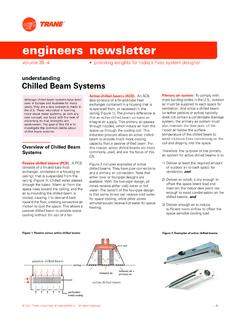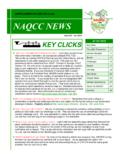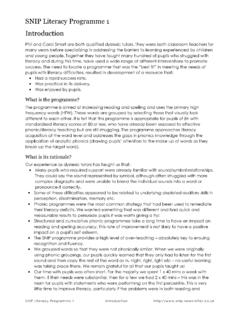Transcription of IN THIS ISSUE What is the best fin shape
1 ISSUE 442 May 2nd 2017 what is the best fin shape for a model rocket? THIS ISSUEC ontinued on page 3 Theoretically, the best fin shape for a rocket is an elliptical fin shape . I wanted to get that conclusion stated right here at the start. Did you get that young student? I m writing this for you. You came to the Apogee web site looking for information on what is the optimum fin shape for a model rocket? , and if you want an answer, then write this statement down on your paper: the elliptical shape is the optimum shape for a model rocket (Figure 1). Please, write that down! It is an acceptable answer to the ques-tion. And now you can go play, your homework is this article, I ll explain why it is the right the-oretical answer. But sometimes, theory runs into practicality, and that might not be the best answer if you are building a model rocket for an altitude competition.
2 The reason I m writing this article is that grade school students come to the Apogee web site and download Apogee Technical Publication #16 what is the Optimum Fin shape for Altitude? ( ), and then send me an email asking that exact same question: which shape is it? I m left shaking my head, wondering where the disconnect was, because they did download the report (I assumed they looked at it) which did tell them what shape was most likely the best . It is obvious that they must not have understood the technical jargon in the report. Otherwise they wouldn t have to ask me what the answer was when it was already answered. So that is why I m writing this article, to try to clarify what was in the Technical Publication #16 report in simpler is the Elliptical Fin the best shape ?
3 The reason the elliptical fin shape is best is that it produces the least amount of induced drag. Induced drag is a fancy aeronautical engineer-ing term that means that the drag force produced is actually a result of something else happening. That means that two things are going on at the same time, and that the first thing causes the sec-ond thing to happen. The two things are: 1. The Lift force on the fin is A drag force increase on the fin. The lift force is the key factor. Lift is only creat-ed when the symmetrical airfoil is oriented at an angle-of-attack to the wind. That means the fin is tilted in the wind as it flies would the fin be tilted? That doesn t seem right, because don t we launch the rockets straight up?Yes, we do launch the rockets straight up.
4 And in a perfect world, the wind created over the fin as the rocket rises into the sky would strike the fin right at the leading edge (the very front edge of the fin). Half of the air would flow over each side as the paths of the flowing air were split by the leading edge. No lift would be created in such a situation. All you would have is a small drag force created from profile drag and skin friction the atmosphere that the rocket flies Elliptical(TheoreticalBest!)TrapezoidalS quareRectangularClippedDeltaAbout this NewsletterYou can subscribe to receive this e-zine FREE at the Apogee Components website , or by clicking the link here newsletter Sign-UpNewsletter StaffWriter: Tim Van MilliganLayout/Cover Artist: Chris DuranProofreader: Michelle MasonWhat is the best fin shape for a model rocketBy Tim Van MilliganFigure 1: The elliptical fin (far left) is the best from a theoretical point of 442 | May 2nd, 2017 Page 2 You get:(4) AT 29/13(4) AT 41/18(2) AT 56/18(2) AT 66/18(1) AC-56(1) AC-66 You get:(6) AT 13/18(6) AT 18/18(6) AT 24/18(6) AT 33 to the top side (from the high pressure side to low pressure side).
5 This is not the direc-tion we want the air to flow. We just want the flow of air be parallel to the direction of the rocket. But since it flows around the tip, it now has a perpen-dicular flow direction. In mixes with the parallel flow closer to the rocket body tube, and causes a swirling motion (Figure 3). through is not perfect. Little gusts of wind are always present. what happens when the rocket flies through a small gust of wind is that the rocket sees a slight wind direction change. From the rocket s perspective, it is tilted very slightly relative to the wind flowing over the fin. This is called an angle-of-attack. As soon as the rocket is flying at an an-gle-of-attack (Figure 2), a lift force is created. And this is a good thing. We need this lift force to pull the rocket back to a straight path rela-tive to the air flowing over it.
6 In other words, if it were not for the lift force produced by the fins, the rocket would go unstable. Your rocket will not fly very high if it cartwheels across the sky. Having a lift force to restore the rocket to a straight path is a needed in unguided model rockets. Even though the rocket may not be pointed perfectly straight up, it will still go higher than a rocket that doesn t have any Drag occurs at the tips of the fins (the portion of the fin that is furthest away from the body of the rocket). what happens is that air flows around the corner of the tip edge from the Wind DirectionNo Lift ForceAngle-of-AttackLift Force Continued on page 4 Figure 2: When a symmetrical airfoil is tilted relative to the air flowing over it, it generates a lift 3: When lift occurs, air flows around the edge of the fin, from the high-pressure side on the bottom to the low pressure side on the top.
7 This creates a tip is the best fin shape for a model rocketIssue 442 | May 2nd, 2017 Page 3 Continued from page 4 Continued on page 5 Whenever you change the direction of a moving object, a force is needed. Remember Newton s First Law of Motion? An object will move in a straight line unless a force acts to change the motion. The object in this case is the air molecules in the wind. Since the wind went from flowing parallel to the rocket to per-pendicular to the rocket, a force must have acted on the rocket. We call this force drag, because it slows down the speed of the rocket. And it has the special name of Induced Drag since it occurred because a lift force was the root cause of the air flowing from one side of the fin to the other. Without a lift force, there would be no extra drag force, and hence no induced Does An Elliptical Fin Have The Lowest Induced Drag?
8 The reason the elliptical fin has the lowest induced drag is that the shape of the fin orients more of the lift force closer to the body tube of the rocket because the fin is longer near the body tube. That means there is less of a lift force created near the tip of the fin because the fin is shorter in that section of the fin. Figure 5 shows the span-wise distribution of the lift over the there is less lift near the tip of the fin, the difference in pressure (comparing the pres-sure on the top surface to that on the the bottom surface) is a lot lower near the tip. So less air flows around the tip. Hence, the induced drag force is lower. Lower drag means the speed of the rocket isn t being slowed down as much, so it can coast higher into the sky. That is why you can say that the elliptical fin has the most efficient 4: This rear-view from a computer simulation program shows how the air swirls behind the rocket off of the fin 5: Span-wise lift distribution over an elliptical shaped fin.
9 The summation of the lift forces (dark red line) is closer to the body than it is to the Lift of entire finLift at eachsection of finWhat is the best fin shape for a model rocketIssue 442 | May 2nd, 2017 Continued from page 5 what is the worst shape fin?The worst shape fin would have the highest induced drag. In other words, more air flowing around the tip edge of the fin. So making fins with an axe-head shape (shown in Figure 6) would be the worst, because most of the lift force occurs near the tip, creating more of a pressure differ-ence between the upper surface and the lower surface. That causes more air to flow around the edge of the fin, which increases the induced drag is a real problem for aircraft that fly horizontally through the air. The reason is that it is always present, because a lift force is need-ed to hold the airplane up in the sky.
10 That is why the aircraft makers add those curved-up winglets to the ends of the wing. They are meant to re-duce the air flowing from one side of the wing to the other and thereby lowering the induced drag contrast, in rocketry, we don t need lift to get us into the sky. That is the rocket engine s job. Moreover, we don t even want a lift force, except to keep the rocket stable. The lift comes and goes during the ascent, only present when the rocket hits a small gust of wind that changes the an-gle-of-attack orientation. Then the induced drag kicks in, and slows the rocket down. But once reoriented to a zero degree angle-of-attack, the lift goes away, as does the induced drag. At least until it flies through another little gust of wind from a different on page 6 Figure 6: Axe-head shaped fins would have high induced drag because there is more lift near the tips, creating an even lower air pressure.







